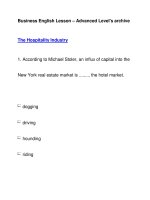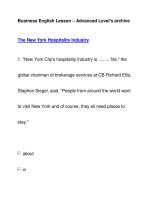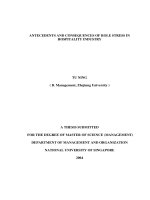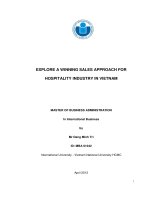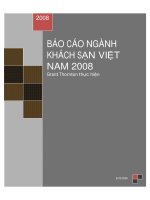Hospitality industry
Bạn đang xem bản rút gọn của tài liệu. Xem và tải ngay bản đầy đủ của tài liệu tại đây (3.74 MB, 326 trang )
Introduction to Hospitality
1
Introduction to Hospitality
Manual on Module II
Introduction to Hospitality
(Fine-tuned version)
2
Introduction to Hospitality
Contributors
Dr Benny Chan, Hong Kong Community College, The Hong Kong Polytechnic
University; Mr Murray Mackenzie, School of Hotel & Tourism Management,
The Hong Kong Polytechnic University and
PSHE Section, Curriculum Development Institute.
3
Introduction to Hospitality
Copyright
© The Government of the Hong Kong Special Administrative Region
All rights reserved.
The copyright of this manual belongs to the Government of the Hong Kong Special
Administrative Region. Commercial use is strictly prohibited. Offenders will be liable to the
legal responsibility.
Schools need not apply for permission to copy this manual in whole or in part for non-profit
making educational or research purposes. All other uses should gain prior permission in
writing from the Government of the Hong Kong Special Administrative Region. Requests
should be directed to the:
Education Bureau
13/F, Room 1319, Wu Chung House
213 Queen’s Road East,
Wan Chai,
Hong Kong
4
Introduction to Hospitality
Acknowledgements
We would like to express our gratitude to the following organizations for giving us the
permission to reprint some of the pictures and /or providing us with information for
completing the curriculum support package:
The Association of National Tourist Office Representatives in Hong Kong, ANTOR (HK)
Centre for Food Safety, Food and Environmental Hygiene Department
FreeDigitalPhotos.net
5
Introduction to Hospitality
Introduction
A set of curriculum support package of tourism and hospitality learning and teaching
materials is being developed by the Personal, Social and Humanities Education Section of
Curriculum Development Institute, Education Bureau for the implementation of the senior
secondary Tourism and Hospitality Studies fine-tuned curriculum in schools. The curriculum
support package is comprised of five manuals, and they are developed to broaden students’
knowledge of the five different units of the Tourism and Hospitality Studies curriculum.
The content of this manual – Introduction to Hospitality, should enhance students’
understanding of the dynamic nature of the tourism and hospitality industry. In addition, the
manual includes activities to deepen students’ understanding and help them to apply theories
and concepts. Furthermore, students should be able to develop enquiry, problem-solving and
decision-making skills through these activities.
All comments and suggestions related to this curriculum support package may be sent to:
Chief Curriculum Development Officer (PSHE)
Personal, Social and Humanities Education
Curriculum Development Institute
Education Bureau
13/F, Room 1319, Wu Chung House
213 Queen’s Road East,
Wan Chai
Hong Kong
June 2013
6
Introduction to Hospitality
Table of Contents
Chapter 1 – Hospitality Industry
p.10
1.1.
Introduction to the Hospitality Industry
p.11
1.1.1.
The Nature of the Hospitality Industry
p.11
1.1.2.
Characteristics of the Hospitality Industry
p.15
1.1.3.
Relationship between the Hospitality Industry and Tourism
1.1.4.
Career Prospect of the Hospitality Industry
p.20
p.22
Chapter 2 – Accommodation Sector
p.29
2.1.
p.30
Introduction to the Accommodation Sector
2.1.1.
Classification of Accommodation Establishment
p.30
2.1.2.
Hotels and Their Classifications
p.30
2.1.3.
Types of Accommodation
p.33
2.1.4.
Common Types of Hotels in Hong Kong
p.38
2.1.5.
Special Hotels Worldwide
p.40
2.1.6.
Hotel Rating Systems
p.45
2.1.7.
The Accommodation Product
p.55
2.1.8.
Types of Hotel Guests
p.71
2.1.9.
Types of Guest Requests
p.73
7
2.2.
Introduction to the Hotel Operations
p.75
2.2.1.
Hotel Ownership
p.75
2.2.2.
Modes of Hotel Management
p.76
2.2.3.
Hotel Departments
p.80
2.2.4.
Rooms Division
p.87
2.2.5.
Front Office Department
p.90
2.2.6.
Housekeeping Department
p.127
Chapter 3 – Food and Beverage Sector
p.157
3.1.
p.158
Introduction to the Food and Beverage Sector
3.1.1.
Food and Beverage Operations (Hotel)
p.158
3.1.2.
Classification of Food and Beverage Services
p.187
3.2.
Food and Beverage Service Principles
p.209
3.2.1.
Basic Knowledge of Menus
p.209
3.2.2.
Basic Knowledge of Food and Beverage Services
p.239
3.2.3.
Restaurant Design and Layout
p.251
3.2.4.
Kitchen Layout for Different Food and Beverage Services
p.261
3.3.
Food Safety and Personal Hygiene
p.272
3.3.1.
Types of Food Contamination
p.272
3.3.2.
Food Safety
p.287
3.3.3.
Safeness in Food Handling Process
p.289
3.3.4.
Personal Hygiene of Catering Practitioners
p.312
8
Introduction to Hospitality
3.3.5.
p.320
Fire Safety
Reference
p.324
9
Introduction to Hospitality
Chapter 1 – Hospitality Industry
Outline of Content:
1.1.1.
The Nature of the Hospitality
1.1.3.
Industry
1.1.2. Characteristics of the Hospitality
Hospitality Industry and Tourism
1.1.4.
Career Prospect of the Hospitality
Industry
Industry
- Product-service Mix
- Positive Views
- Two-way Communication
- Negative Views
- Relationship Building
- Diversity in Culture
- Labor Intensive
Relationship between the
10
Introduction to Hospitality
1.1
Introduction to the Hospitality Industry
1.1.1 The Nature of the Hospitality Industry
What is the meaning of HOSPITALITY? There is
no one single and simple definition to explain the
term of hospitality in this stage. Many people have
tried to describe the hospitality industry in different
ways. Some tried to summarize the scope of the
industry and its characteristics of involving both
tangible and intangible features in the service
delivery process. Others attempted to describe the
industry by exploring the stakeholders involved, mutual benefits generated and the
industry’s impacts to the society and economy.
Broadly speaking, Hospitality is the act of kindness in welcoming and looking after
the basic needs of customers or strangers, mainly in relation to food, drink and
accommodation. A contemporary explanation of Hospitality refers to the relationship
process between a customer and a host. When we talk about the “Hospitality
Industry”, we are referring to the companies or organisations which provide food
and/or drink and/or accommodation to people who are “away from home”. However,
this definition of the “Hospitality Industry” only satisfies most situations.
In this chapter, a brief summary about the characteristics and scope of the hospitality
industry would be provided.
Resort hotel
11
Introduction to Hospitality
ACTIVITY 1.1
In groups, consider the hospitality industry in Hong Kong. Discuss the different
sectors in the hospitality industry. (Hint: A sector of hospitality industry can be
profit-making or non-profit-making.) You may also give the names of some
enterprises in the hospitality industry. One example has been given in the table
below. Work on the table to see which group in your class comes up with the most
appropriate examples.
Hospitality industry in Hong Kong
Sector
Products/services
Example
provided
Food and
Beverage
enterprise/
organisation
Food and drink
Fast food
Name of
12
McDonald’s
Introduction to Hospitality
ACTIVITY 1.2
A. Look at the table that your group has just completed and compare the
answers with other groups.
1.
Have you been to any of the above enterprises or organisations?
2.
What services did you receive from them?
3.
Were you satisfied with the way you were treated by the enterprise or its
staff?
4.
Did they understand what services you wanted?
5.
Did they provide what you wanted quickly and accurately?
6.
Was the staff member friendly or rude?
B.
Based on the discussion above, suggest five qualities or traits that a
successful staff member in the hospitality industry should possess.
1.
Do you or your group members possess any of these qualities or traits?
13
Introduction to Hospitality
ACTIVITY 1.3
Now work in pairs and follow the instructions below:
Tourist A – You are an 18-year-old student from Beijing. You visit Hong Kong
for the first time with your cousin who is also from Beijing this summer. As you
are a student, you travel on a budget and are planning to come to Hong Kong
round trip by train. You plan to stay in Hong Kong for 5 days/4 nights.
Tourist B – You are a businessman from Sweden. Your enterprise is a car
manufacturer. You come to Hong Kong for an international automobile
exhibition. You will fly to Hong Kong and stay for two nights before you fly to
Singapore for another business meeting. You will stay in Singapore for two
nights before going home.
In two minutes, write down as many as possible of the products and services you
would require from the different sectors of the tourism industry for your trip.
Compare your answers with those of your partner. Do you have different or
similar answers? How many of the points you jotted down are similar to those of
your partner?
Fill in the following table:
A young student (Tourist A)
A business traveler (Tourist B)
14
Introduction to Hospitality
In Activity 1.3, we learned there are different kinds of tourists. Regardless of what
type of tourist they are, they all need shelter and food and drink – the basic hospitality
services – at ALL points of the tourism cycle, not just at the destination. This is why
hospitality can be referred to as one of the principal dimensions in tourism, along with
transportation, specialist shops and leisure activities
1.1.2 Characteristics of the Hospitality Industry
We learned about different types of products and services provided by the hospitality
industry and explored some key attributes of being a professional staff in the
hospitality industry through completing Activity 1.1-1.3. We understand that working
in the field of hospitality could be quite challenging. Different from other sectors, the
hospitality industry is unique in its nature which tends to be service-oriented and has a
strong emphasis on human exchange in the service delivery processes. A summary of
key characteristics relating to the hospitality industry are listed in Figure 1.1 as below:
Product-service mix
Two-way communication
Characteristics of
Relationship building
the Hospitality
Industry
Diversity in culture
Labor intensive
Figure 1.1– Characteristics of the Hospitality Industry
15
Introduction to Hospitality
1.
Product-Service Mix
Think about your experience of being a customer in a restaurant or a customer in a
hotel. What else, apart from the food in restaurants and the facilities in hotel rooms,
do you think can make your hospitality experience more enjoyable and satisfied?
In the hospitality industry, customers rarely consume pure products but a mixture of
products and services. For example, one who dines in a restaurant will not only pay
for the food and drinks but the services provided by the servers. The bill has covered
both tangible and intangible experience.
Tangible features- for example, a steak as the main course, a glass of house wine, well
groomed service staff and decoration of the restaurant.
Intangible features- for example, a comfortable dining atmosphere or the friendly
attitude of staff.
A successful hospitality business does not only count on its products and services, but
also how they are delivered. The qualities of staff and the way they deliver the service
are often more important than the tangible products in making a hospitality experience
satisfactory or unsatisfactory. Hence, the two features can contribute to the total
experience in the service delivery process.
As products and other tangible features can be easily imitated by competitors,
hospitality operations which aimed for high-ended customers and ‘superior’ quality
gradually spend more and more resources in enhancing the service standard as a
strategy of differentiation.
2.
Two-way Communication
In order to achieve service excellences in the
hospitality industry, two-way communication is
one
critical
factor
which
requires
the
involvement and participation of both customers
and service staff in the service delivery process.
Through interactions with customers, important
messages about their needs and expectations can be received by service staff for their
immediate actions to create customer satisfaction. Interactions between internal staff
or inter-departments is also critical since total experiences of customers in using any
16
Introduction to Hospitality
lodging or food and beverage services usually involve team work and exchange of
information within the organization.
3.
Relationship Building
The hospitality industry highly depends on repeated customers for survival. Building
long term relationship with customers can benefit the organizations for generating
stable revenues regardless of the instability of seasons and at the same time,
developing brand reputations through positive word-of-mouth of the repeated
customers. In order to develop brand loyalty,
different methods are currently applied by
the lodging and food service sectors, such as
membership
privileges
programmes
and
incentives
which
to
give
frequent
customers. However, top management of
Mr. John Chan
organizations do believe that the informal
ways of building “friendship” between
front-line staff and customers through high degree of personal attention and
customization can win the loyalty of customers in long run.
4.
Diversity in Culture
As hospitality are closely related to tourism
industry, it is not surprising that people
involved in this sector, no matter customers or
staff are experiencing a diversity in culture
through interacting with others. Staff who work
in a hospitality organization always have
interactions with customers from different
regions, or to work and corporate with other colleagues who may have different
backgrounds or cultures. Due to their differences in religious beliefs and values, some
conflicts and misunderstandings can be easily occurred. Therefore, staff should be
17
Introduction to Hospitality
open-minded, and come up with solutions together in resolving problems in their
duties. For example:
From customers’ perspective, some of them abstain from meat due to their religious
beliefs or habit. Therefore, restaurants should provide vegetarian food as an option in
order to satisfy their needs.
From staff’s perspective, eating pork or any food products with pork as ingredient
should be avoided if some colleagues are Muslims in order to show respect to their
religious belief.
Such a cultural diversity implicates that local staff should generally understand
different cultures so flexible services can be provided to customers based on their
national cultures and harmony in cooperation with colleagues from different
nationalities can be achieved.
5.
Labor Intensive
Since
the
hospitality
industry
is
service-oriented in its’ nature, it requires a
huge supply of labors to create a memorable
experience for the customers. This
characteristic is especially true for those
enterprises which target for high-ended
customers. For example, staff-to-guest ratios
are high in fine dining restaurants and 5-star
hotels which aimed at providing one-on-one
services to their customers. Although the advancement in technology do contribute to
the replacement of some simple tasks in the whole service process, customers who
concern the element of ‘care’ generally expect high degree of human contacts and
personalized services in their consumption experiences. It explains why the industry is
always in high demand for labor and is willing to spent time and resources in training
and recruiting potential candidates to join the workforce of the hospitality industry.
18
Introduction to Hospitality
ACTIVITY 1.4-Problems Relating to Cultural Differences
Assuming that you are now working as a waiter/waitress in a resort hotel and you
have been informed by your manager that a new colleague coming from India will
report duty and join the team in this morning.
Instructions:
Refer to curriculum support material (part 4) – “Customer Relations and
Services” – p.36, about the customs of India.
State 3 situations that you may encounter when working together with the new
colleague.
Suggest 3 “do’s” and “don’ts” in communicating with the new colleague and
put your answers in the table below.
Examples of Situations
Don’ts
Do’s
1.
2.
3.
19
Introduction to Hospitality
1.1.3 Relationship Between the Hospitality Industry and Tourism
Scope of the Hospitality Industry
“Guests” means those who are away from their
homes and it therefore, has generated a
perception that the hospitality industry should
include or overlap with the tourism industry to a
certain extent. Without a clear definition about
the scope of the hospitality industry, some
suggested that it should not only cover all
lodging and food service operations but other tourism
related operations, such as airlines and theme parks.
Besides, there were also some who considered putting
hospitality and tourism into one industry. One example
of categorization is shown in Figure 1.2.
Hospitality and Tourism Industry
Examples:
Examples:
Examples:
Examples:
• Cruises
• Airlines
• Rails
• Hotels
• Motels
• Service
apartments
• Restaurants
• Cafés
• Bars
• Attractions
• Parks
• Gaming facilities
Travel
Lodging
Food Service
Recreation
“Lodging and food service are the cores under the scope of hospitality industry.”
Figure 1.2– Scope of the Hospitality and Tourism Industry
20
Introduction to Hospitality
ACTIVITY 1.5-Service Experience in the Hospitality Industry
Based on your past experience in using the services in accommodation or food
service operations, try to discuss with your classmates (in a group of 4) and
suggest 4 important requirements for being a professional staff in the hospitality
industry.
Unlike tourism, hospitality, however, serves both tourist and non-tourist needs. To
enhance your understanding of the relationship between the hospitality and tourism
industry, complete Activity 1.6.
ACTIVITY 1.6
The following diagram shows the relationship between the hospitality and tourism
industry. Can you think of more services with examples to add to the diagram?
Hospitality Industry Tourism Industry
Institutional/
Welfare Catering
e.g. Hospital
Catering
Commercial
Accommodation
Services
e.g. Hotels,
Guest Houses
21
Transportation services
e.g. Car Rental,
Airlines
Introduction to Hospitality
In Activity 1.6 we learned the hospitality industry is a part of a wider group of
economic activities called tourism. In addition, not all hospitality businesses are
profit-making business.
In this Unit, we have learned that there are two main business sectors in the
hospitality industry:
z
Accommodation – To provide accommodation (and usually food and drink)
to people who for whatever reason are away from home
z
Food and beverage – To provide food and beverage to local, commuting,
transient customers and tourists
These two sectors will be covered in more detail in Units 2 and 3 respectively.
As we have seen, the hospitality industry includes hotels and restaurants, as well as
many other types of organisations or institutions that offer food, drink, shelter and
other related services. These products and services are offered not only to people
away from home, but also to local customers. A manager in the hospitality industry,
therefore, must keep in mind the following three objectives:
1.
Making the customers feel welcome personally;
2.
Making things work for the customers; and
3.
Making sure that the operation will continue to provide service and meet its
budget.
1.1.4 Career Prospect of the Hospitality Industry
There are always some pros and cons for working in the hospitality industry. The
concern whether a position suits to you or not is mainly dependent on your own
character and personal interest. Some general views, both positive and negative, about
the career prospects of hospitality industry are summarized below as reference for
those who may have intentions to join this unique and challenging industry.
22
Introduction to Hospitality
1. Positive Views
a) Variety of Career Choices
Due to the booming development of the
hospitality and tourism industry, many new hotels
and restaurants are opened for catering the needs
of both the visitors and locals. It facilitates a huge
demand of labor in the market, especially in some developing countries. Career
choices are not limited to Hong Kong but other countries offered by international
chains. And the job natures are broad, ranging from different back-of-the-house to
front-of-the-house positions in the hospitality industry. Some positions that can be
selected by graduates with their certificates or diplomas relating to hospitality are
highlighted in Table 1.1 below:
Accommodation Sector
Food Service Sector
Other Related Sectors
• Front desk receptionist
• Waiter / waitress
• Tour guide
• Room attendant
• Host / hostess
• Tour escort
• Telephone operator
• Cashier
• Travel agent
• Reservation
• Food runner/Busser
• Theme park crew
• Concierge
• Bartender
• Event sales
• Bellman/Doorman
• Apprentice
• Business center
associate
• Commis
• Other“customer service”
positions
• Banquet server
Table 1.1-Career Opportunities of Graduates Studying Hospitality Programs
23
Introduction to Hospitality
ACTIVITY 1.7-Your Preferred Job in the Hospitality Industry
Instructions:
Work as a group of 4 to 5.
Suggest 2 different positions in the hospitality industry, which you and your
classmates would have interest to experience in the future.
State the advantages that can be provided for choosing the selected positions
as your future careers.
What are the requirements or disadvantages of the selected positions?
Among the 2 choices, which one is more preferable and suitable to you?
Share and compare your results with other groups in the class.
b) Opportunities to Meet People with Different Backgrounds
As mentioned earlier that the success of a
hospitality service highly depends on the human
contact between staff and customers. Having a
chance to work in the industry, particularly in some
front line positions means that there would be many
opportunities for one to meet and communicate with
people with different backgrounds and cultures. For
example, a hotel receptionist can perceive his/her position as a tourist ambassador,
which can be enjoyable and challenging. The job satisfaction through winning
customers’ smiles, as well as its’ interactive nature make hospitality industry
attractive to youngsters with an out-going character.
24
Introduction to Hospitality
c) Long-Term Career Development
It is common that most people have to start their careers from the entry-level.
However, the career paths are always quite clear for employees and there are always
opportunities for them to get promoted and proceed to management levels based on
their experience and performance. Successful stories are numerous in this sector and
someone starting from room attendant can finally turn into the general manager of a
hotel. Figure 1.3 shows a sample career path provided to employees by a famous fast
food chain available in Hong Kong.
Operations Manager
Operations Consultant /
Senior Operations
Training Manager
Training Consultant /
Senior Training
Top Management
Level
Store Manager
First Assistant Manager
Second Assistant Manager
Middle Management
Level
Manager Trainee
Team Leader
Trainer
Entry Level
Crew
Trainee
Figure 1.3-Sample Career Path in a Fast Food Chain
25
